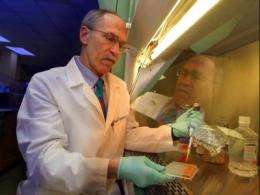Exercise can forestall osteoporosis

The stage for osteoporosis is set well before menopause—but exercise can help rewrite the script, according to Medical College of Georgia researchers.
Declining estrogen levels have long been associated with osteoporosis, but bone density starts to decline years before these levels drop, according to Dr. Joseph Cannon, Kellet Chair in Allied Health Sciences and principal investigator of the National Institute of Aging-funded study. It's during that time that levels of follicle-stimulating hormone, released by the pituitary gland to help regulate ovarian function, actually increase.
Cannon theorizes that higher levels of FSH decrease bone mineral density by increasing cytokines, regulatory proteins produced by white blood cells. One cytokine in particular, interleukin-1, signals certain cells to transform into osteoclasts, which break down and resorb bone. "We hypothesize that the higher levels of FSH decrease bone mineral density by influencing the production of cytokines," said Cannon, who presents his team's research at the American Physiological Society's Experimental Biology 2010 conference in Anaheim, Calif. April 24-28.
After measuring FSH and bone mineral density in 36 women between the ages of 20 to 50, the researchers correlated higher FSH levels with lower bone mineral density. When they incubated FSH with white blood cells isolated from the women, it stimulated production of interleukin-1. Moreover, higher circulating levels of IL-1 correlated with lower bone mineral density, if the levels of interleukin-1 inhibitory factors were taken into account.
Additionally, they found that study participants who exercised more than 180 minutes a week retained greater bone density.
"Our work provides more evidence that physical activity is important for maintaining bone density. It's a case of 'use it or lose it,'" Cannon said, citing his team's findings that exercise seemed to promote inhibitory factors that help keep interleukin-1 and bone breakdown under control.
The team's next step is to determine how exercise influences the expression of interleukin-1 inhibitory factors.













